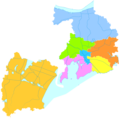Wuxi dialect
 From Wikipedia - Reading time: 8 min
From Wikipedia - Reading time: 8 min
This article needs additional citations for verification. (August 2023) |
| Wuxi | |
|---|---|
| 無錫話 | |
| Native to | People's Republic of China |
| Region | Wuxi, Jiangsu province |
| Language codes | |
| ISO 639-3 | – |
wuu-wux | |
| Glottolog | wuxi1234 |
| Wuxi dialect | |||||||||||||||
|---|---|---|---|---|---|---|---|---|---|---|---|---|---|---|---|
| Simplified Chinese | 无锡话 | ||||||||||||||
| Traditional Chinese | 無錫話 | ||||||||||||||
| |||||||||||||||
The Wuxi dialect (Simplified Chinese: 无锡话; Traditional Chinese: 無錫話; Pinyin: Wúxīhuà, Wu: mu1 sik1 wo3, Wuxi dialect: [vu˨˨˧ siɪʔ˦ ɦu˨]) is a dialect of Wu. It is spoken in the city of Wuxi in Jiangsu province, China.
It has many similarities with Shanghainese and the Suzhou dialect. It is mutually intelligible with the Changzhou dialect to which it is most closely related.[citation needed] It is not at all mutually intelligible with Mandarin, China's official language.
Phonology
[edit]Initials
[edit]| [1] | Labial | Dental | Alveolar | Palatal | Velar | Glottal | |
|---|---|---|---|---|---|---|---|
| Nasal | m | n | ɲ | ŋ | |||
| Plosive/ | voiceless | p | t | ts | tɕ | k | ʔ |
| aspirated | pʰ | tʰ | tsʰ | tɕʰ | kʰ | ||
| slack voice | b | d | dz | dʑ | g | ||
| Fricative | voiceless | f | s | ɕ | x | h | |
| slack voice | v | ɦ | |||||
| Lateral | l | ||||||
Finals
[edit]Tones
[edit]| Middle Chinese tone | ||||
|---|---|---|---|---|
| píng 平 | shǎng 上 | qù 去 | rù 入 | |
| yīn 陰 | ˥˧ (53) | ˧˥ (35) | ˦ (44) | ʔ˥ (55) |
| yáng 陽 | ˨˦ (24) | ˨˩˧ (213) | ʔ˩˨ (12) | |
References
[edit]- ^ Chao 1976, p. 49.
External links
[edit]Wikimedia Commons has media related to Wuxi dialect.
Licensed under CC BY-SA 3.0 | Source: https://en.wikipedia.org/wiki/Wuxi_dialect22 views | Status: cached on August 01 2025 03:47:21↧ Download as ZWI file
 KSF
KSF

